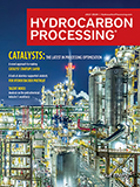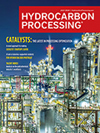Topsøe researchers announce breakthrough on refining catalysts
Haldor Topsøe’s researchers were able, for the first time, to see the Co-Mo-S catalyst’s crystallites, which are only a few nanometers wide.
The news accompanies the publication of the breakthrough study in the peer-reviewed scientific journal, Angewandte Chemie.
The Co-Mo-S is the scientific term for the active part of Haldor Topsøe’s TK catalysts series that are used globally by refineries for various refining processes. The obtained images disclose detailed knowledge about the structure of the catalyst.
The research could facilitate development of more efficient refining catalysts. New insight on catalyst systems can also promote cleaner environment solutions and help the refining industry to manage more stringent environmental legislation.
“These first-ever images show exactly how the individual atoms in the catalysts are arranged," said Stig Helveg, senior research scientist for Topsøe and one of the authors of the Angewandte Chemie article.
"Knowing how the atoms are arranged in the real catalysts helps to explain what makes a catalyst good or bad. In particular we need to know the exact position of Co, as that element is a spice that really makes the catalyst stand out."
Atom-by-atom understanding
“Such images are very difficult to obtain and are at the edge of what is physically possible, simply because we need to distinguish each and every atom in the crystallites," added Helveg.
"We have, therefore, worked for a long time with Dr. Quentin Ramasse at the SuperSTEM facility in Daresbury and Dr. Christian Kisielowski at Lawrence Berkeley National Lab. Especially, Dr. Ramasse has a highly sophisticated microscope available that made it possible to obtain these first-ever images."
Having the right microscope available is only part of why the researchers were able to produce the images. Equally important was the close collaboration between Topsøe’s researchers and Dr. Ramasse and Dr. Kisielowski over the last five years.
Improved oil refinery catalysis
Gasoline, diesel and other fossil fuels contain small amounts of sulfur (S) and nitrogen (N), which are emitted to the atmosphere during fuel combustion. These elements are harmful to human health and the environment. Catalytic processes are used in oil refineries to reduce S and N emissions.
However, more efficient catalysts are urgently needed to keep up with the increasing oil consumption, use of “dirtier” crude oil feeds and more stringent environmental legislation.
“To design such boosted catalysts, we need a detailed picture of how the catalyst looks and functions at the atomic level,” Helveg says.
Today, the catalyst consists of small crystallites of the mineral molybdenum disulfide (MoS2). The crystallites are just a few nanometers wide. Moreover, the cobalt (Co) atoms are attached the crystallites to boost the catalysis.
Since the 1970s, the structure of the catalyst has been debated intensively by the scientific world. In the 1980s, researchers at Topsøe suggested the so-called Co-Mo-S model, which at that time was fundamentally different from established beliefs and it created much debate.
Although the model is widely accepted today, no one has ever seen, atom-by-atom, the Co-Mo-S catalysts used in oil refineries.






Comments